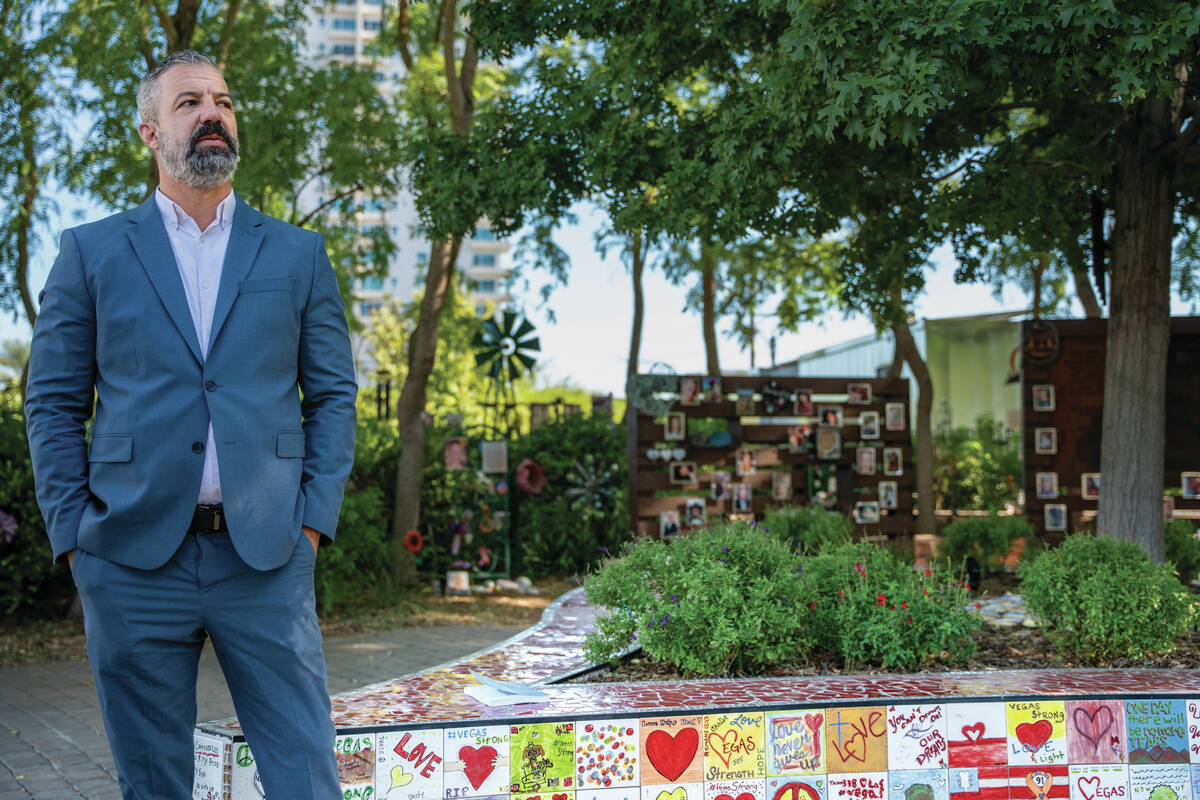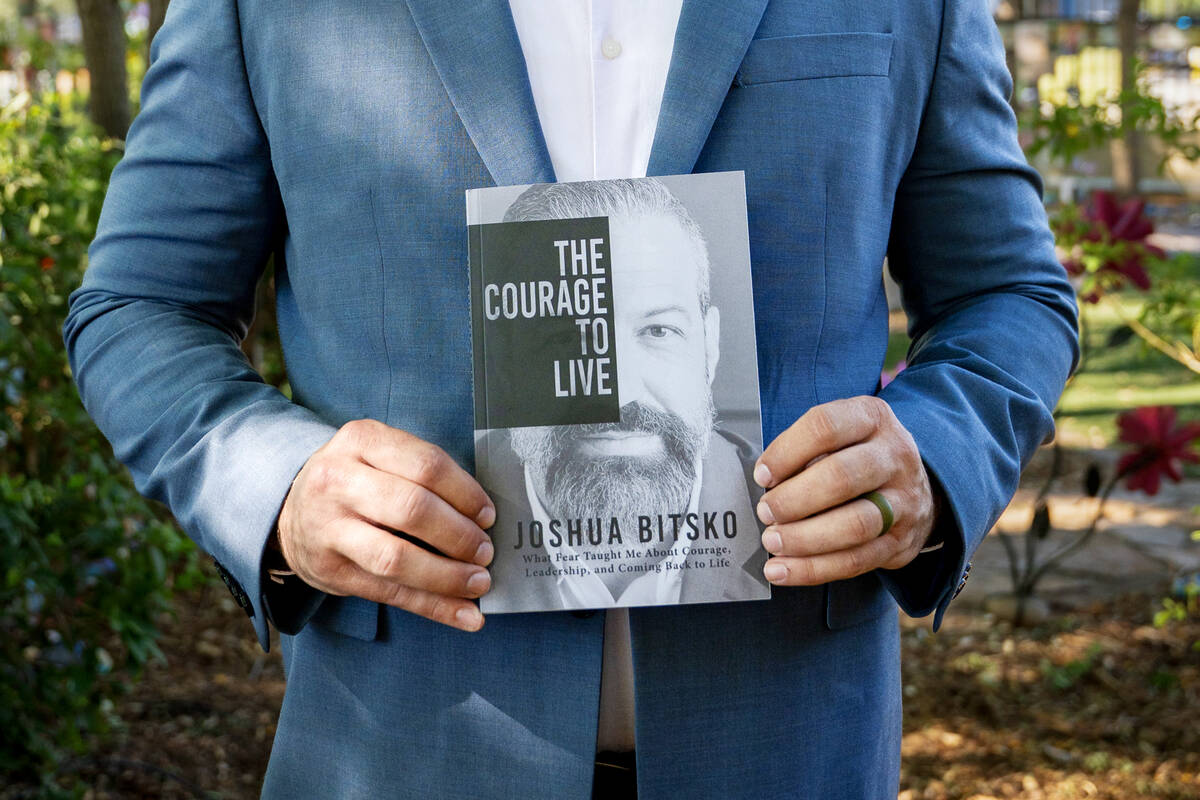‘A normal day … until it wasn’t’: Ex-officer recounts Las Vegas mass shooting in book
The date is never far from Josh Bitsko’s mind. But when the anniversary of Oct. 1, 2017, comes around, dark thoughts are inescapable.
After all, he was there. Bitsko, at the time a Metropolitan Police Department sergeant, was one of a handful of people who entered the gunman’s 32nd-floor hotel room at Mandalay Bay, minutes after he shot hundreds of people attending a country music festival on the Strip.
“Everybody who went up to that room came down different,” Bitsko said. “That was a normal day … until it wasn’t.”
Part of Bitsko’s effort to deal with the trauma he witnessed was to make his experiences public. His new book, “The Courage to Live,” became available Wednesday, eight years after the shooting that took lives, changed lives and was seared into the collective consciousness of the community.
Talking about that night can still be difficult for Bitsko, a 2000 graduate of Basic High School in Henderson.
The toll is still nearly inconceivable. Sixty died. Hundreds were injured.
It was the deadliest mass shooting in modern American history.
For Bitsko, there is still guilt and second-guessing. There are still nightmares, usually centering around a room service cart that was outside the hotel room. As he put it, it’s “not something that you can get away from.”
‘We thought it was an explosive device’
The outdoor Route 91 Harvest festival drew more than 22,000 country music fans to an outdoor venue across from the Luxor.
Shortly after 10 p.m., reports started to come on police scanner channels about gunshots being heard on the Strip.
A K-9 sergeant for Metro at the time, Bitsko, now 45, said he began to hear the sounds of automatic gunfire over the police radio system.
He later learned that witnesses were talking about a possible shooter at Mandalay Bay, near Las Vegas Boulevard and Russell Road. Initially, he thought Las Vegas was “under attack,” possibly at the hands of multiple terrorists.
Bitsko and another officer entered the massive Mandalay Bay complex from its southwest side, near the Shark Reef Aquarium. Bitsko had his rifle out, though people on the casino floor, he said, seemed completely normal. They didn’t yet know what was happening.
Officers first were told there was a shooter on the 29th floor. They later learned the shooter was on the 32nd floor, high above Las Vegas Boulevard.
“At first, it was like a game of telephone between security at Mandalay Bay and our dispatchers,” Bitsko said. “When we got to the 32nd floor, there was a room service cart outside the hotel room. It had wires coming from underneath it, so we thought it was an explosive device.”
In fact, Bitsko said he was almost certain it was an explosive device, likely wired to be remotely detonated by the shooter from inside the room.
Bitsko didn’t know it at the time, but the wires were there because the gunman had rigged a surveillance system so he could see what was happening in the hallway.
Though Bitsko was trained as a first responder, he said he was faced with a decision: proceed and quite possibly die or retreat.
He could have left to get a bomb-sniffing dog or waited for reinforcements to arrive. Instead, Bitsko said he and two other officers went right to the cart to breach the door of one of the rooms. They would find the shooter dead from a self-inflicted gunshot wound.
“Part of the reason why I wrote this book was because we have to, as first responders, overcome these human emotions that we’re all built to have,” Bitsko said. “Fear is there for a reason — it’s a survival instinct. That night, it was just so different than anything I had experienced. People can freeze in those moments because they become overwhelmed with these emotions.”
The aftermath
Since the shooting, Bitsko said he has been through hours and hours of therapy sessions.
During the interview for this story, which took place at the city’s downtown Community Healing Garden, dedicated to the memory of those lost in the shooting, Bitsko became emotional at times.
As a helicopter hovered above, he glanced up several times. He’s always aware of his surroundings.
Bitsko stands 6 feet 2 inches tall. He practices martial arts and he boxes.
He said writing a book about his experience and the aftermath has helped.
“At first, I was numb,” he said. “For a long time, I was just cruising through life — not feeling anything good or bad and using unhealthy coping mechanisms. I didn’t enter therapy until years after the shooting, but part of the reason why I wrote this book was because there’s a blueprint where, even if you’re witness to mayhem like that, you can still live and enjoy life.”
One of the hardest parts of the shooting to get past, Bitsko said, is the fact that no one likely will ever know the gunman’s motive.
Deborah Kuhls, the chief of trauma at University Medical Center who was a senior trauma surgeon at the facility in 2017, agreed with that sentiment.
She said the night of the shooting and its aftermath were so traumatic for the hospital’s staff, mental health resources were made available by management.
“It’s really difficult to reconcile why a person would take so much time to plan something that killed and injured so many innocent people,” Kuhls said. “It was very sad. We’re trained to deal with the things that we see, so we have to be calm so we can do our jobs, but that was a wild night. I hope to never experience something like that again.”
Bitsko, who lives in northwest Las Vegas with his family, said it remains a process to emotionally deal with what he went through.
Retired from law enforcement, he now focuses on the consulting company he started in 2023, which aims to teach resiliency and leadership for first responders. In his own words, he teaches people they can “make good decisions even when they’re scared.”
To date, he hasn’t attended any of the Oct. 1, 2017, memorial services.
“I know there’s all the different events, but generally what I do (on the anniversary) is book a therapy appointment,” Bitsko said. “I’ll be honest, I just haven’t had the heart to go to those things. I do think it’s important for the community to come together on that day. I might go to an event one day.”
Contact Bryan Horwath at bhorwath@reviewjournal.com. Follow @BryanHorwath on X.


























